Snow camping presents unique challenges and rewards for outdoor enthusiasts. From the crisp air to the stunning landscapes, camping in the snow offers a one-of-a-kind experience. However, to truly enjoy this adventure, you need the right equipment, and perhaps the most crucial piece of gear is your tent.
Choosing the best tent for snow camping requires careful consideration of various factors, including weather resistance, insulation, durability, and weight. With a plethora of options available on the market, selecting the perfect tent can be overwhelming.
Weather Resistance
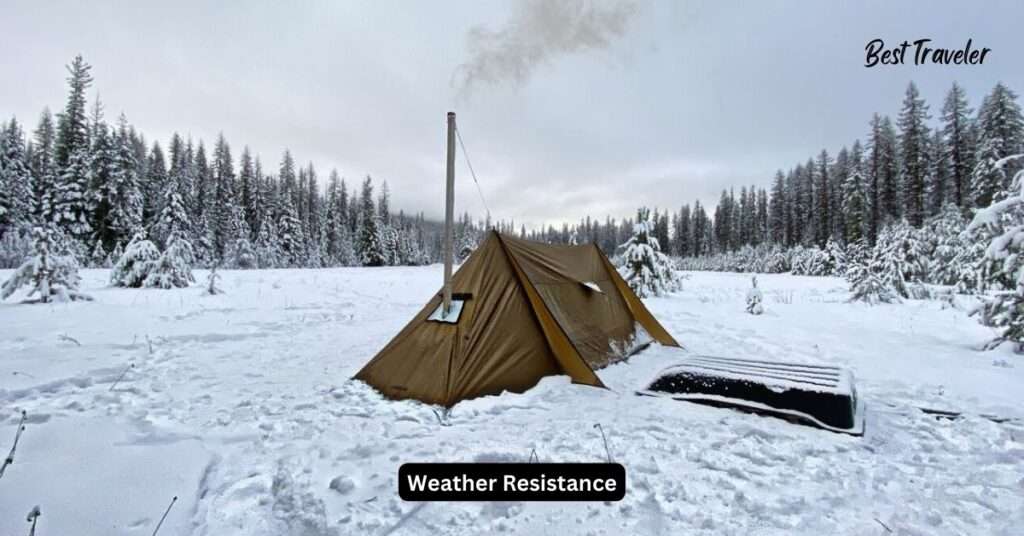
When camping in snowy conditions, your tent must withstand harsh weather elements such as wind, snow, and cold temperatures.
Waterproofing
Waterproofing in camping is a crucial aspect of ensuring comfort and safety in outdoor adventures, particularly in wet or snowy conditions. It involves treating camping gear, such as tents, tarps, and clothing, with specialized coatings or materials to prevent water penetration.
In the context of tents, waterproofing typically refers to the treatment of the tent fabric to repel moisture and keep the interior dry during rain or snowfall. This is achieved through the application of waterproof coatings or membranes, such as polyurethane (PU) or silicone, which create a barrier that prevents water molecules from seeping through the fabric.
Additionally, seam sealing is essential to prevent water ingress through the stitching holes. Properly waterproofed tents not only keep campers dry but also protect gear and provide a comfortable shelter in inclement weather. Regular maintenance, such as reapplication of waterproofing treatments and seam sealing, is essential to ensure the longevity and effectiveness of waterproof gear.
Snow Flaps
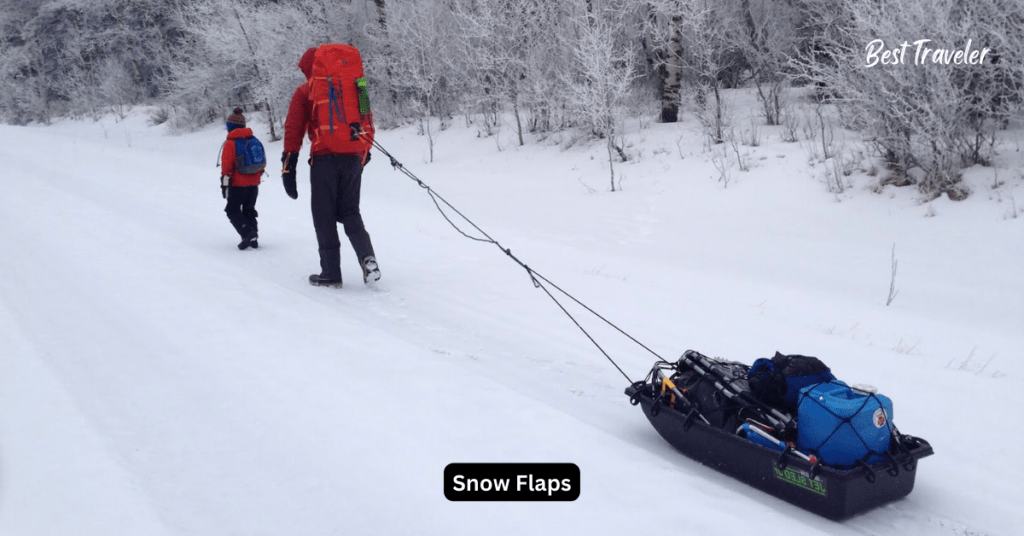
Snow flaps, also known as snow skirts or snow valances, are specialized features found on some tents designed for use in snowy environments. These flaps extend outward from the bottom perimeter of the tent, creating a barrier between the tent’s walls and the ground.
The purpose of snow flaps is to prevent snow from blowing or drifting into the interior of the tent during windy conditions. By effectively blocking snow accumulation around the tent’s base, snow flaps help maintain a warmer and drier interior environment. This is particularly important in snow camping scenarios, where exposure to cold and moisture can pose significant challenges.
Snow flaps are typically made from the same durable and weather-resistant materials as the tent body and are securely attached to the tent’s base. They often feature adjustable straps or cords to ensure a snug fit and can be deployed or stowed away as needed.
Overall, snow flaps are a valuable feature that enhances the performance and functionality of tents in snowy conditions, contributing to a more comfortable and enjoyable camping experience.
Insulation
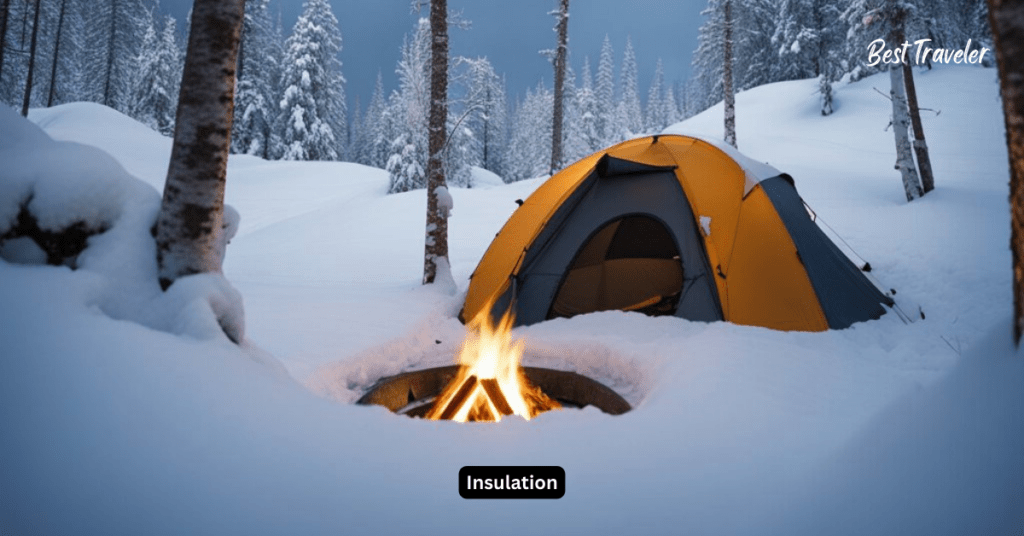
Staying warm is crucial when camping in the snow, as cold temperatures can pose significant risks such as hypothermia and frostbite.
Double-Walled Construction
Double-walled construction is a design feature commonly found in camping tents, particularly those intended for use in cold or wet environments. This construction consists of two separate layers: an inner tent and an outer rainfly.
The inner tent provides the primary living space for campers, offering privacy and protection from insects and condensation. It is typically made from breathable materials that allow moisture vapor to escape, minimizing the buildup of condensation inside the tent.
The outer rainfly serves as a waterproof barrier, shielding the inner tent from rain, snow, and wind. It is usually made from durable, waterproof materials such as nylon or polyester, and is designed to repel water while still allowing air to circulate.
The space between the inner tent and the rainfly acts as a buffer zone, providing additional insulation and helping to regulate temperature inside the tent. Double-walled construction offers several advantages for camping in challenging conditions.
It provides enhanced weather protection, improved ventilation, and increased versatility, allowing campers to adapt to changing weather conditions with ease. Additionally, the separate inner and outer layers make it easier to pitch and pack the tent, reducing setup and teardown times.
Overall, tents with double-walled construction are a popular choice for campers seeking reliable performance and comfort in a variety of outdoor environments.
Tent Shape

Tent shape plays a crucial role in determining its performance and suitability for different camping environments. There are various tent shapes available, each offering unique advantages and drawbacks depending on the intended use and conditions.
One common tent shape is the dome tent, characterized by its rounded, dome-like structure supported by flexible poles crossing over each other. Dome tents are popular for their stability and ability to withstand wind and snow loads due to their low profile and aerodynamic design. They also offer ample headroom and floor space, making them comfortable for extended camping trips.
Another popular tent shape is the tunnel tent, which features a long, tunnel-like structure supported by curved poles running parallel to each other. Tunnel tents provide excellent interior space and are ideal for accommodating multiple campers or gear storage. They are also relatively lightweight and easy to pitch, making them a favorite among backpackers and trekking enthusiasts.
Additionally, there are A-frame tents, characterized by their triangular shape with steeply sloping sides and a central ridgepole. A-frame tents are simple and easy to set up, but they may not offer as much interior space or headroom compared to dome or tunnel tents. However, their compact size and stability make them suitable for solo campers or minimalist expeditions.
Durability
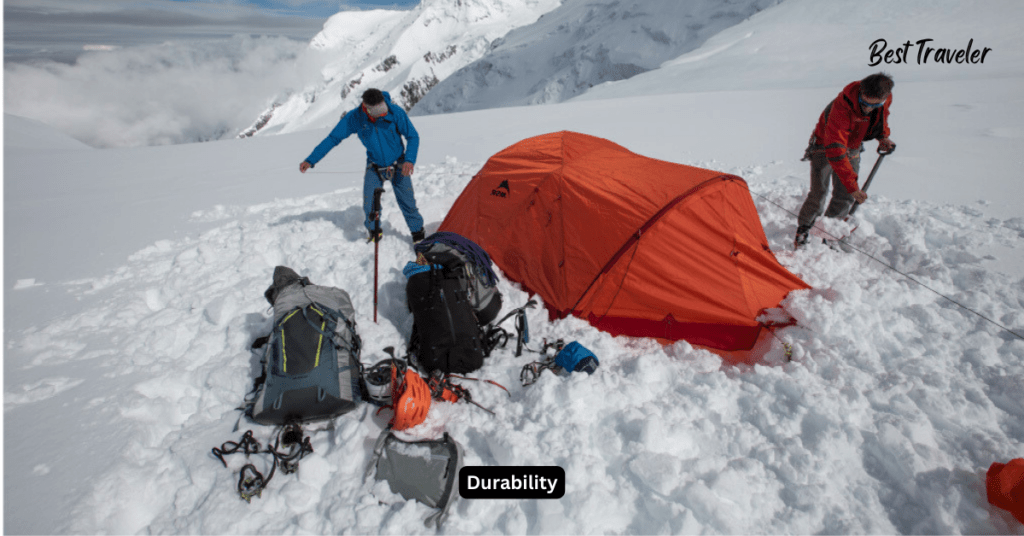
Snow camping can be demanding on your gear, with exposure to abrasive snow, strong winds, and freezing temperatures.
Strong Materials
Strong materials are fundamental in the construction of camping gear, particularly tents, to withstand the rigors of outdoor adventures. When it comes to tents, the choice of materials directly impacts durability, weather resistance, and overall performance in challenging conditions. Common materials used in tent construction include ripstop nylon, polyester, and canvas, each offering distinct strengths and characteristics.
Ripstop nylon is a lightweight yet durable fabric known for its strength and tear resistance. It is often used in the construction of tent bodies and rainflies, providing reliable protection against abrasion and punctures. Additionally, ripstop nylon is treated with waterproof coatings to enhance weather resistance, making it suitable for camping in wet or snowy environments.
Polyester is another popular choice for tent materials due to its durability and UV resistance. Polyester tents are known for their longevity and ability to maintain their shape and color over time, even with prolonged exposure to sunlight. They offer excellent weather resistance and are often more affordable than tents made from other materials.
Freestanding Design
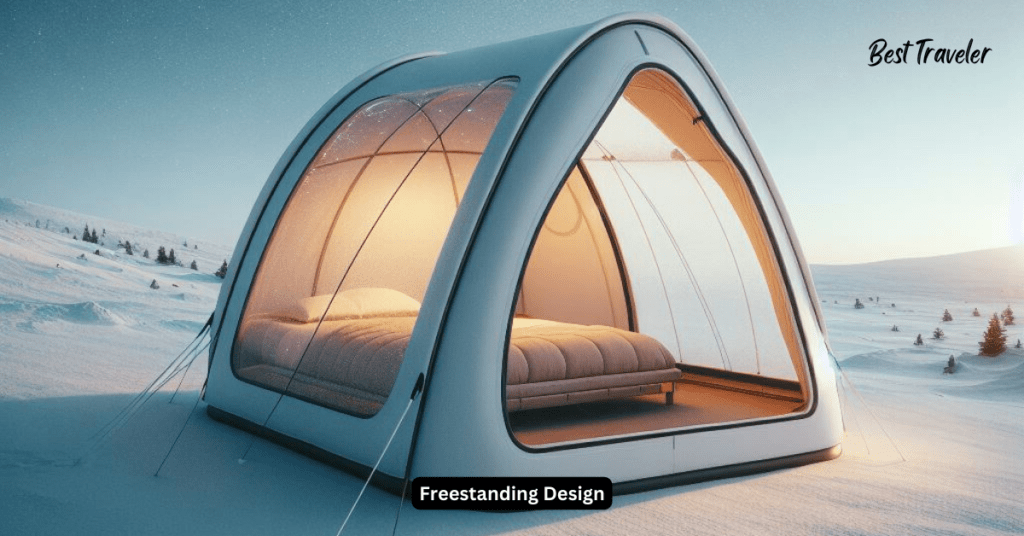
A freestanding design is a key feature found in many camping tents, offering convenience, versatility, and stability in various outdoor environments. Unlike non-freestanding tents that rely on stakes and guy lines for support, freestanding tents are self-supporting structures that can stand upright without the need for additional anchoring. This design is achieved through the use of sturdy poles and a tensioned framework that allows the tent to maintain its shape independently.
One of the primary advantages of a freestanding tent is its ease of setup. Campers can pitch a freestanding tent on any flat surface, whether it’s rocky terrain, sand, or even a wooden platform. This flexibility allows for greater freedom in choosing a campsite and eliminates the need to search for suitable anchor points or adjust guy lines.
Freestanding tents also offer versatility in camping arrangements. Since they are not dependent on stakes for support, campers can easily reposition or move the tent after it has been pitched. This is particularly useful in situations where the terrain is uneven or when camping in areas with limited space.
Furthermore, freestanding tents tend to be more stable in windy conditions compared to non-freestanding tents. The self-supporting structure distributes wind forces evenly across the tent’s frame, reducing the risk of collapse or damage. This stability provides peace of mind to campers, especially in unpredictable weather environments.
Weight

While durability and weather resistance are essential, the weight of your tent is also a crucial consideration, especially if you’ll be trekking long distances to your camping spot. A lightweight tent can significantly reduce your pack weight and make your snow camping adventure more enjoyable.
Packability
Packability is a critical consideration when choosing camping gear, particularly tents, as it directly impacts ease of transport and convenience during outdoor adventures. In the context of tents, packability refers to how easily and compactly the tent can be folded or rolled up and stored in a backpack or vehicle for transport. A tent’s packability is influenced by several factors, including its size, weight, and design features.
One of the primary determinants of a tent’s packability is its overall size and dimensions when packed. Tents designed for backpacking or hiking typically prioritize compactness, with smaller footprints and streamlined designs that minimize bulk. These tents often feature lightweight materials and collapsible poles to reduce packed size without sacrificing structural integrity.
Weight also plays a significant role in a tent’s packability, especially for backpackers and adventure seekers who need to carry all their gear on their backs. Lightweight tents constructed from ultralight materials such as Dyneema or Cuben Fiber offer excellent packability, allowing campers to save space and weight in their backpacks for other essentials.
Ultralight Materials

Ultralight materials have revolutionized the world of camping gear, offering outdoor enthusiasts the opportunity to shave precious ounces off their pack weight without compromising on performance or durability. In the context of camping, ultralight materials refer to fabrics, components, and construction techniques specifically engineered to minimize weight while maintaining essential functionality and strength.
One of the most common ultralight materials used in camping gear is Dyneema Composite Fabric (DCF), formerly known as Cuben Fiber. DCF is an incredibly lightweight yet durable material made from laminated layers of Dyneema fibers, resulting in a fabric that is significantly lighter and stronger than traditional nylon or polyester.
Tents constructed from DCF offer exceptional tear and abrasion resistance while weighing a fraction of their counterparts, making them an ideal choice for backpackers and thru-hikers looking to reduce pack weight without sacrificing durability.
Another popular ultralight material is silicone-coated nylon, which provides excellent waterproofing and durability at a minimal weight penalty. Silicone coatings are applied to lightweight nylon fabrics to enhance water resistance while maintaining breathability, making them suitable for rainflies, ground cloths, and tent bodies in ultralight camping setups.
Conclusion & Recap
In conclusion, selecting the right camping gear, including tents, involves considering a multitude of factors such as weather resistance, insulation, durability, weight, and packability. Each aspect plays a crucial role in determining the overall performance and comfort of camping equipment, impacting the outdoor experience of adventurers.
Weather-resistant materials, such as ripstop nylon and polyester, along with features like snow flaps and double-walled construction, ensure protection from the elements in harsh conditions. Durability is essential for withstanding the rigors of outdoor adventures, with strong materials and reinforced seams contributing to long-lasting gear.
Additionally, the weight and packability of camping gear are crucial considerations for backpackers and hikers, who prioritize lightweight and compact equipment for ease of transport. By carefully evaluating these factors and selecting gear that aligns with individual needs and preferences.
Campers can enjoy safe, comfortable, and memorable experiences in the great outdoors. Whether embarking on a weekend camping trip or an extended wilderness expedition, investing in quality camping gear ensures preparedness for whatever adventures lie ahead.
FAQs
What is the difference between a 3-season and a 4-season tent?
A 3-season tent is designed for use in spring, summer, and fall, offering ventilation and protection from rain and moderate winds. On the other hand, a 4-season tent, also known as a winter or mountaineering tent, is built to withstand harsh winter conditions, including heavy snowfall and high winds. It features stronger poles, reinforced construction, and less mesh for better insulation.
How do I know what size tent to choose for my camping trip?
Tent size is determined by the number of occupants and their gear. Most tents are labeled with their capacity, indicating the number of people they can comfortably accommodate. However, it’s essential to consider not just the number of people but also the gear storage space needed. For example, a 2-person tent may be suitable for two people but may not have enough room for gear.
What is the difference between down and synthetic sleeping bags?
Down sleeping bags are filled with natural down feathers, known for their exceptional warmth-to-weight ratio and compressibility. They are lightweight and highly insulating but lose their warmth-retaining properties when wet. Synthetic sleeping bags, on the other hand, are filled with man-made fibers that provide insulation even when damp. While they may be slightly heavier and bulkier than down bags, they are often more affordable and easier to care for.
How should I care for my camping gear to ensure its longevity?
Proper maintenance is essential for prolonging the life of camping gear. Tents should be stored dry, cleaned regularly, and treated with waterproofing spray as needed. Sleeping bags should be aired out after each use, stored uncompressed, and washed according to manufacturer instructions. Backpacks should be emptied, cleaned, and stored in a dry place to prevent mold and mildew growth.
What are some essential items to pack for a camping trip?
Essential items for a camping trip include a tent, sleeping bag, sleeping pad, camp stove, cookware, water filtration or purification system, first aid kit, headlamp or flashlight, and appropriate clothing for the weather. Other useful items may include a multi-tool, fire starter, navigation tools, insect repellent, and bear-resistant food storage containers, depending on the location and duration of the trip.

